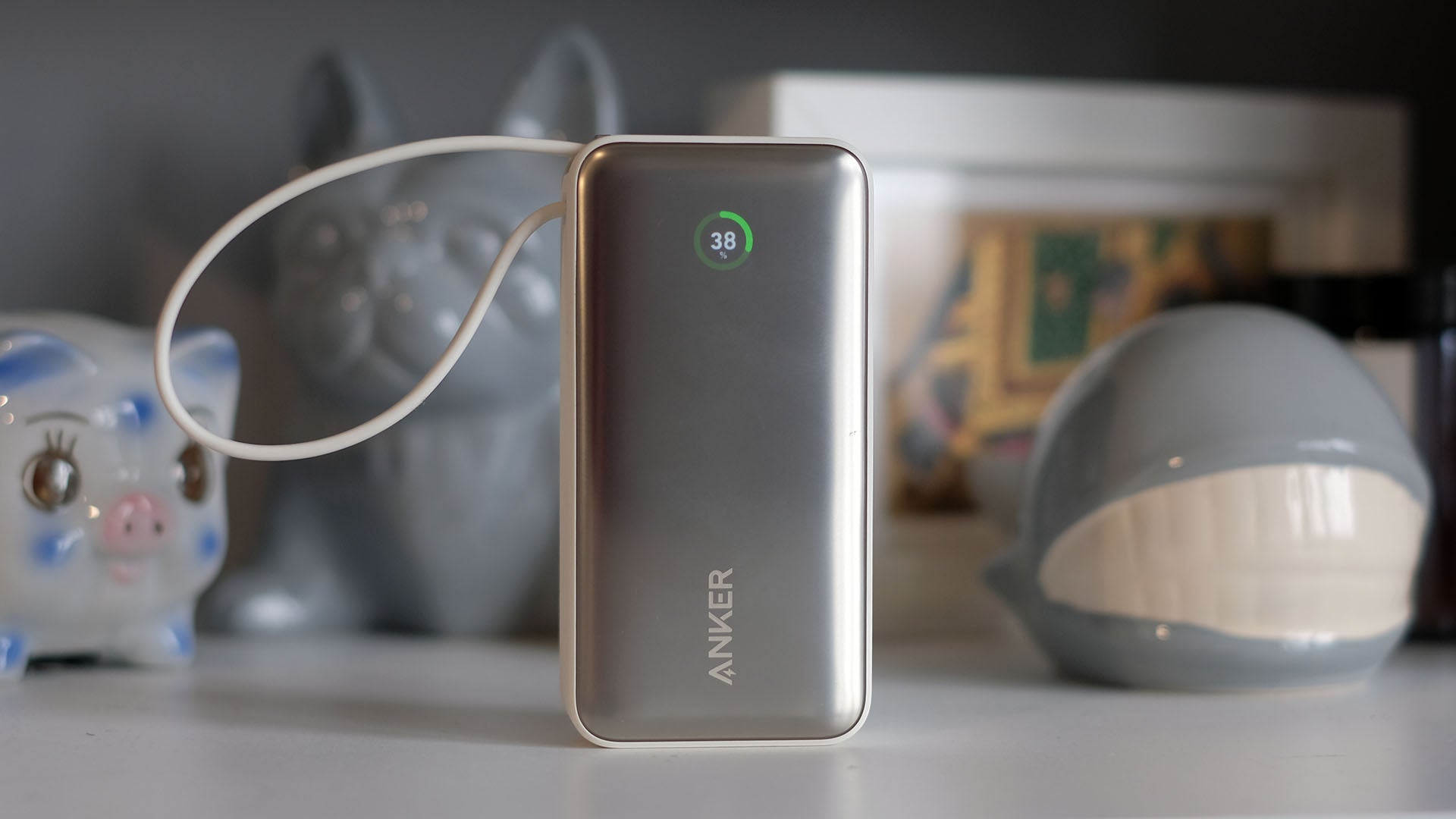Verdict
Cuter and classier than the average power bank, the Nano hides a neat little screen behind a smokily metallic front. It’s not quite as impressive on the technical side, but it can still hold its own against mid-tier contenders.
Pros
- Slick integrated display
- Solid capacity for size
- Fills up fairly quickly
Cons
- Making a cable a handle is not sensible
- Efficiency could be slightly higher
- Not quite
-
Integrated cable A USB-C cable is built into the battery, and can be used as a carry handle (if you dare) -
30W chargingThe battery itself charges at up to 30W, for a full recharge from flat in 91 minutes. -
Integrated displayA small screen sits behind the shimmery, metallic-looking front, and can display the battery percentage.
Introduction
The Anker Nano is an all-purpose power bank with a couple of neat touches. It has a built-in cable, which can be used to both charge the battery and to plug in gadgets you want to actually charge up.
It also has an invisible screen. Behind its frosted front is a little colour display that provides a percentage estimate of the battery level and the time remaining — whether that’s until the battery is fully charged or fully depleted.
As a result, you pay around double the amount you might expect from a basic 10,000mAh battery. However, you also get triple the charging speed of one of those basic models, with a very iPhone-friendly 30W output.
Design
- Swish front display
- Pocketable size and shape
- Carry handle is cute but questionable
Nano is a potentially misleading name for this battery pack. It is not actually tiny. It’s a similar size to a small brick-like feature phone, and thicker than most of those too.
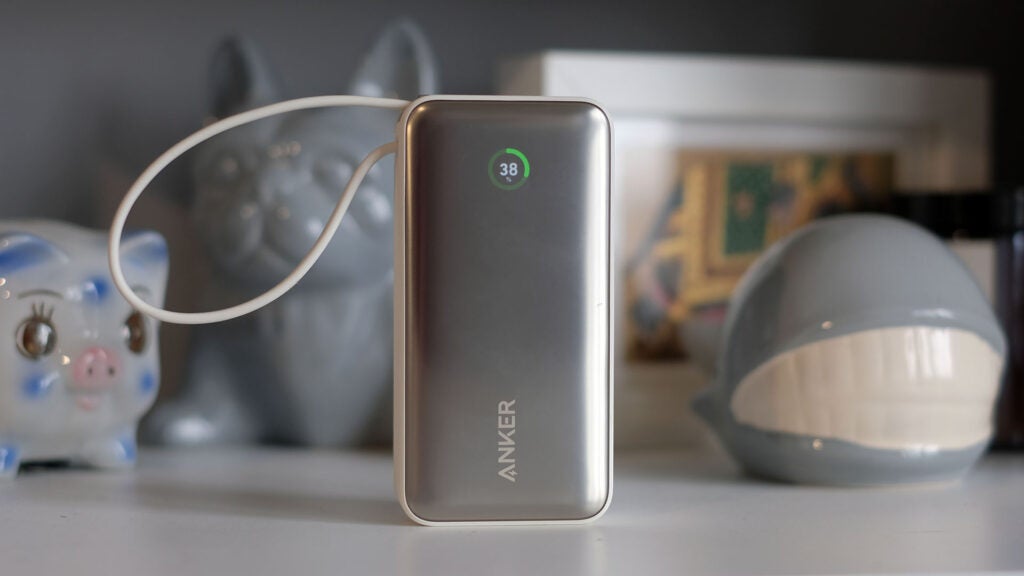
It’s 104mm tall, 26mm thick, and weighs a smartphone-like 215g. I wouldn’t call that “nano” size, but the Anker Nano is still an ideal size and shape for most, as it will fit into pockets just fine.
Its shell is plastic, and uses a corrugated-style texture on the sides to avoid looking or feeling too basic. The front is a frosted silver. It looks metallic but, again, it’s plastic. And the display sits behind that translucent silvery layer, which makes the border of the screen completely invisible.
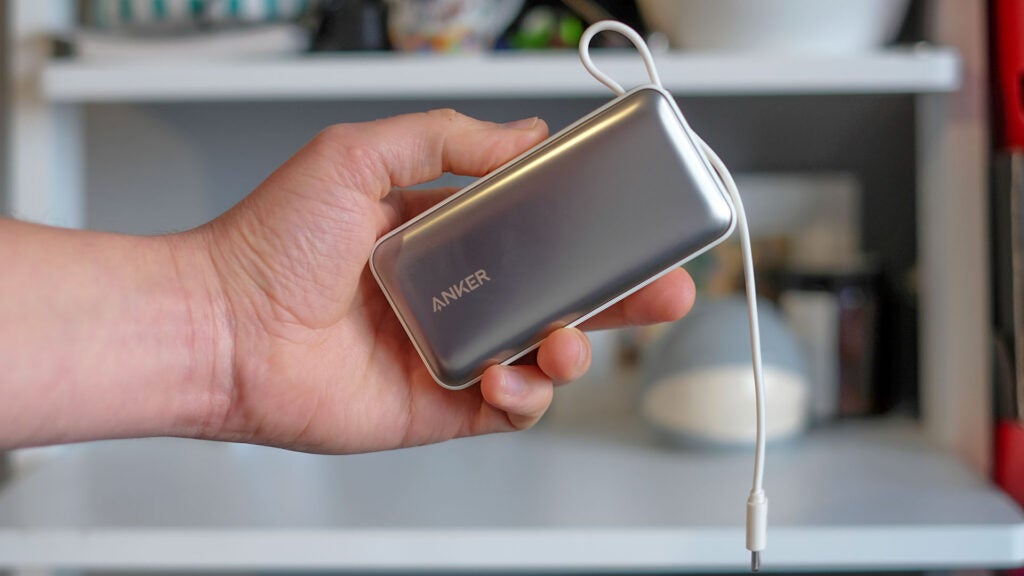
When you press the single button up top, the display’s characters appear, as if floating in those silvery mists of the front panel. It’s a rather nice effect.
The screen shows the current charge level, with a neat-looking ring around the letters. Next to this you’ll also see an estimate of how long the battery will last at the current output, or an estimate of how much charging time is left. For a power bank that, at the time of review, is actually on sale for £34, these smart extras are nice additions.
I like how the power level display operates too. Most indicators like this show 100% a long time before the battery actually stops charging. In reality, the final charge stage typically goes on a lot longer, at a slower rate. But here the Nano displays 99% until it is well and truly finished.
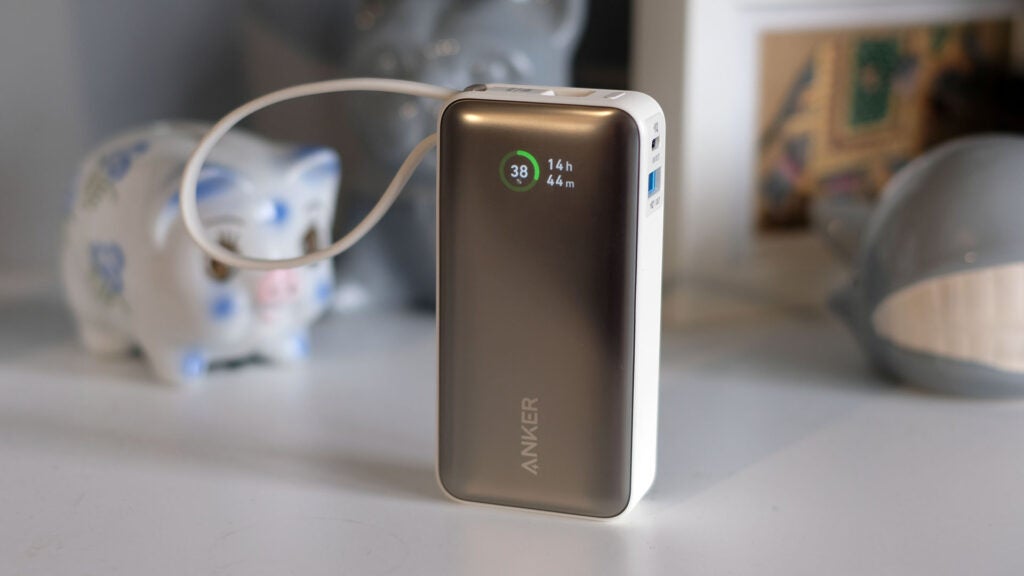
This also means that, in my testing, the display shows 1 minute left for a total of 25 minutes. That may change as the battery calibration adjusts, though.
I’m not sure how smart the other USP is: the integrated cable. There’s nothing wrong with the concept, but the execution leads you to naturally assume it should be used as a strap. I can picture people flinging this around a finger like some sort of stress toy, and I can’t see how this could possibly end well.
Applying stress to the point where the terminal meets the cable and where the cable comes out of the main block seems a terminally bad idea. You’ve been warned. Anker doesn’t seem to agree, though. It calls it a “built-in handle,” and there is a certain degree of fortification at both ends.
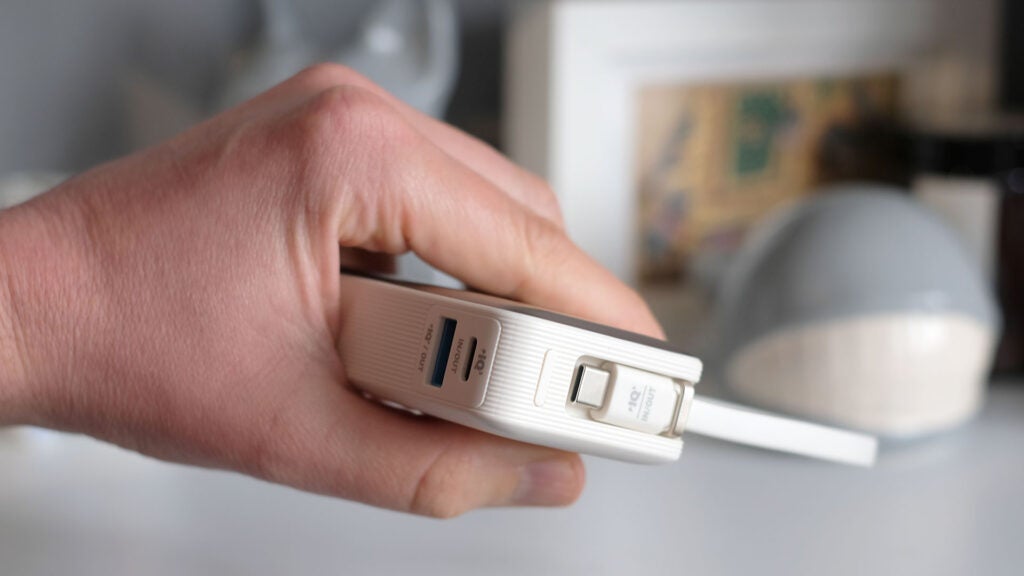
Thankfully, the integrated cable is not your only option. The Anker Nano has an additional USB-C connector and a USB-A connector on the side. The USB-C can be used just like the integrated cable, to either charge the Nano or to connect other stuff.
Performance
- Fair 76.9% efficiency
- The battery itself charges swiftly
- 24W output is ideal for iPhones, a touch low for today’s Androids
The Anker Nano is a 10,000mAh battery pack, but it actually uses two 5000mAh cells. Charging it up from flat, a full charge clocked in at 36.28Wh, equivalent to 9805mAh. That last sip may be kept in reserve as the screen will still be able to display “0%” charge after it refuses to hook up to any other devices. You ideally don’t want to drain a lithium battery entirely anyway.
That charge took 91 minutes. It can take in 30W of power, and sucks up electricity at that rate until it hits around the 80% mark. That takes an hour. The draw level then gradually slopes downwards, which is neat as it means the last few percent don’t take an eternity.
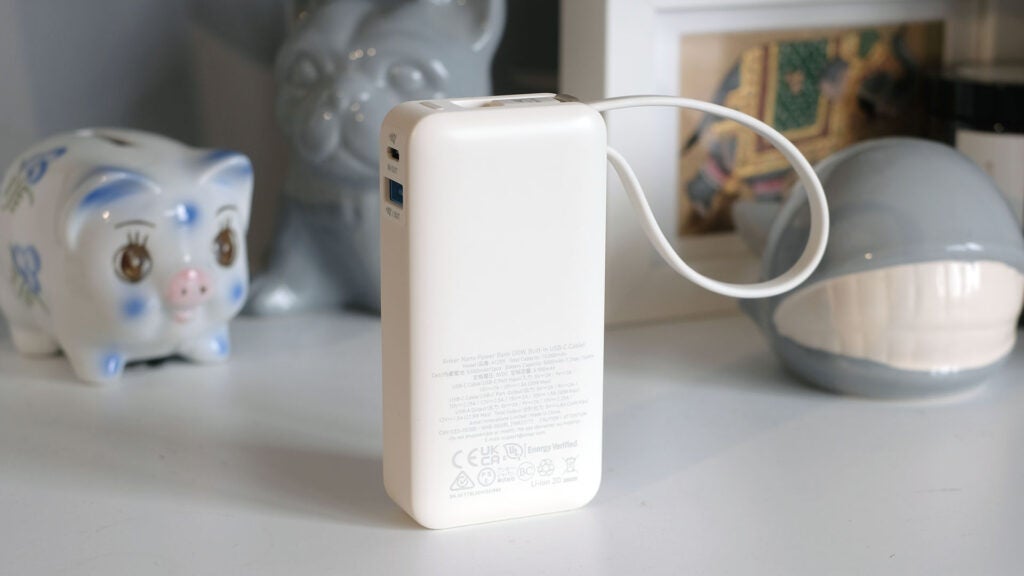
My recorder took showed the Nano can actually supply 27.9Wh of energy, equating to efficiency of 76.9% or a mAh figure of 7540mAh. This is an OK result, but you ideally want to see that figure reach into the 80s with a higher quality battery pack like this.
The Nano can supply 30W charge, as well as receiving 30W. But that amount is spread across the three sockets (22W max for the USB-A). While the wide range of supported output voltages (5V/9V/15V/20V) makes it suitable for laptop charging, it doesn’t have the juice to do so at full speed for today’s average-quality laptop.
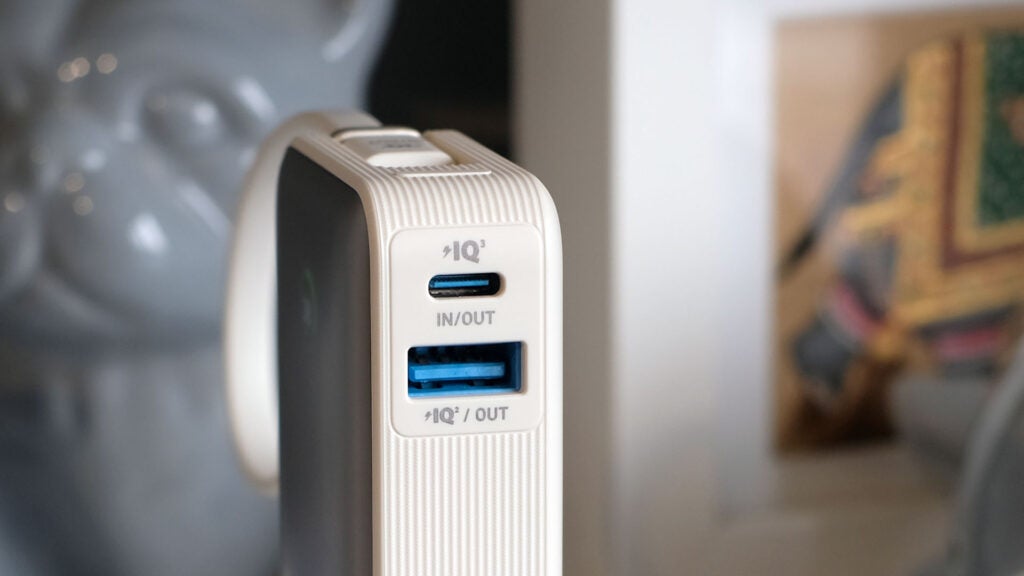
Based on my testing with some devices, the Anker Nano Power Bank 30W can also be a little temperamental about reaching 30W.
This is not a world-beating battery pack, but it does provide solid capacity, respectable enough efficiency and decent charging speeds, particularly if you are an iPhone user.
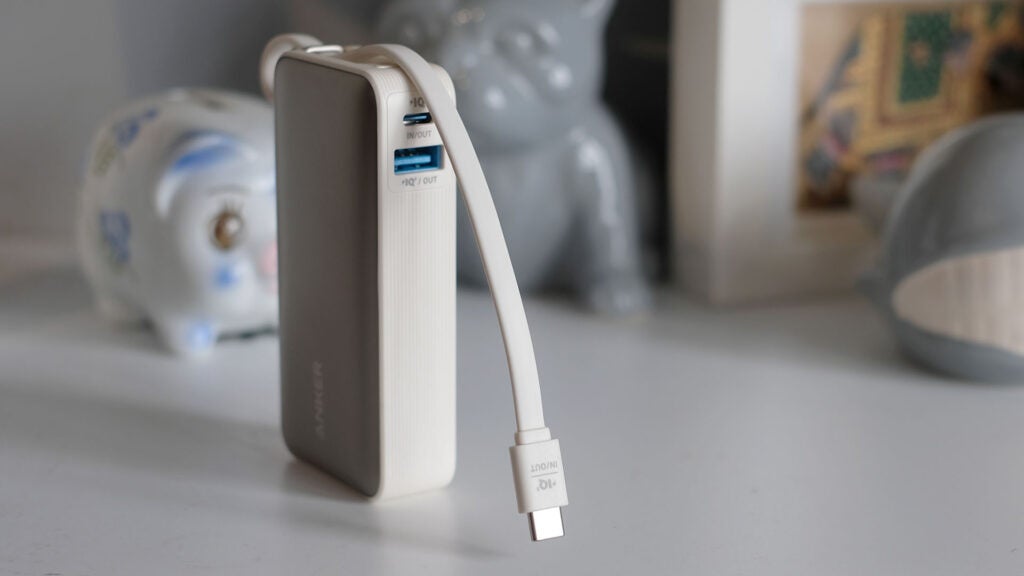
I did find it can be pretty picky about the adapter you use to charge the Nano up, though. To reach its maximum 30W ceiling, you need to have a charger capable of 15V or 20V. But even when using a 125W Motorola charger, it was still stuck at around 15W for some reason. Switching to a Samsung charger fixed the issue.
If you find your Anker Nano isn’t charging as fast as expected, it may well be an adapter compatibility issue.
Latest deals
Should you buy it?
You want a glossier battery bank
Thanks to its built-in screen and cable, the Nano has a bit more to offer than the average vanilla power bank. Having a percentage to work with gives you a much better idea of whether the bank needs a recharge.
You want true fast charging
Actual charge speed is limited to 24W, not the headline 30W, which may seem a bit low if you have an Android phone that can charge at 65W or more.
Final Thoughts
The Anker Nano is a nifty mid-price battery pack small enough to fit in your jeans pocket. It seems more high-tech than the average battery too, as it has a built-in screen that’s hidden until it lights up.
Charge efficiency is only acceptable rather than stellar, and it can only reach the charging limits of iPhones rather than fast-charging Androids, but it’s a likeable pick.
The idea of using the power cable as a carry handle, which the design invites, seems a flat-out bad idea, though. If you’re of the same mind you should consider the Anker 553. It’s a very similar battery pack, and has an extra USB-C socket rather than an integrated cable.
How we test
We thoroughly test every power bank at Trusted Reviews, using a USB Voltimeter to not only test elements like maximum wattage but to measure its total output to gain insight into efficiency and more.
Tested input, output, maximum wattage and more using a USB voltimeter
MagSafe charging tested with an iPhone 15
FAQs
It has no official water resistance rating.
It doesn’t support wireless charging at either end, to charge devices or to be charged itself.
It can charge iPhones, but its integrated cable is USB-C, so it won’t plug into older iPhones.
Verdict
Cuter and classier than the average power bank, the Nano hides a neat little screen behind a smokily metallic front. It’s not quite as impressive on the technical side, but it can still hold its own against mid-tier contenders.
Pros
- Slick integrated display
- Solid capacity for size
- Fills up fairly quickly
Cons
- Making a cable a handle is not sensible
- Efficiency could be slightly higher
- Not quite
-
Integrated cable A USB-C cable is built into the battery, and can be used as a carry handle (if you dare) -
30W chargingThe battery itself charges at up to 30W, for a full recharge from flat in 91 minutes. -
Integrated displayA small screen sits behind the shimmery, metallic-looking front, and can display the battery percentage.
Introduction
The Anker Nano is an all-purpose power bank with a couple of neat touches. It has a built-in cable, which can be used to both charge the battery and to plug in gadgets you want to actually charge up.
It also has an invisible screen. Behind its frosted front is a little colour display that provides a percentage estimate of the battery level and the time remaining — whether that’s until the battery is fully charged or fully depleted.
As a result, you pay around double the amount you might expect from a basic 10,000mAh battery. However, you also get triple the charging speed of one of those basic models, with a very iPhone-friendly 30W output.
Design
- Swish front display
- Pocketable size and shape
- Carry handle is cute but questionable
Nano is a potentially misleading name for this battery pack. It is not actually tiny. It’s a similar size to a small brick-like feature phone, and thicker than most of those too.

It’s 104mm tall, 26mm thick, and weighs a smartphone-like 215g. I wouldn’t call that “nano” size, but the Anker Nano is still an ideal size and shape for most, as it will fit into pockets just fine.
Its shell is plastic, and uses a corrugated-style texture on the sides to avoid looking or feeling too basic. The front is a frosted silver. It looks metallic but, again, it’s plastic. And the display sits behind that translucent silvery layer, which makes the border of the screen completely invisible.

When you press the single button up top, the display’s characters appear, as if floating in those silvery mists of the front panel. It’s a rather nice effect.
The screen shows the current charge level, with a neat-looking ring around the letters. Next to this you’ll also see an estimate of how long the battery will last at the current output, or an estimate of how much charging time is left. For a power bank that, at the time of review, is actually on sale for £34, these smart extras are nice additions.
I like how the power level display operates too. Most indicators like this show 100% a long time before the battery actually stops charging. In reality, the final charge stage typically goes on a lot longer, at a slower rate. But here the Nano displays 99% until it is well and truly finished.

This also means that, in my testing, the display shows 1 minute left for a total of 25 minutes. That may change as the battery calibration adjusts, though.
I’m not sure how smart the other USP is: the integrated cable. There’s nothing wrong with the concept, but the execution leads you to naturally assume it should be used as a strap. I can picture people flinging this around a finger like some sort of stress toy, and I can’t see how this could possibly end well.
Applying stress to the point where the terminal meets the cable and where the cable comes out of the main block seems a terminally bad idea. You’ve been warned. Anker doesn’t seem to agree, though. It calls it a “built-in handle,” and there is a certain degree of fortification at both ends.

Thankfully, the integrated cable is not your only option. The Anker Nano has an additional USB-C connector and a USB-A connector on the side. The USB-C can be used just like the integrated cable, to either charge the Nano or to connect other stuff.
Performance
- Fair 76.9% efficiency
- The battery itself charges swiftly
- 24W output is ideal for iPhones, a touch low for today’s Androids
The Anker Nano is a 10,000mAh battery pack, but it actually uses two 5000mAh cells. Charging it up from flat, a full charge clocked in at 36.28Wh, equivalent to 9805mAh. That last sip may be kept in reserve as the screen will still be able to display “0%” charge after it refuses to hook up to any other devices. You ideally don’t want to drain a lithium battery entirely anyway.
That charge took 91 minutes. It can take in 30W of power, and sucks up electricity at that rate until it hits around the 80% mark. That takes an hour. The draw level then gradually slopes downwards, which is neat as it means the last few percent don’t take an eternity.

My recorder took showed the Nano can actually supply 27.9Wh of energy, equating to efficiency of 76.9% or a mAh figure of 7540mAh. This is an OK result, but you ideally want to see that figure reach into the 80s with a higher quality battery pack like this.
The Nano can supply 30W charge, as well as receiving 30W. But that amount is spread across the three sockets (22W max for the USB-A). While the wide range of supported output voltages (5V/9V/15V/20V) makes it suitable for laptop charging, it doesn’t have the juice to do so at full speed for today’s average-quality laptop.

Based on my testing with some devices, the Anker Nano Power Bank 30W can also be a little temperamental about reaching 30W.
This is not a world-beating battery pack, but it does provide solid capacity, respectable enough efficiency and decent charging speeds, particularly if you are an iPhone user.

I did find it can be pretty picky about the adapter you use to charge the Nano up, though. To reach its maximum 30W ceiling, you need to have a charger capable of 15V or 20V. But even when using a 125W Motorola charger, it was still stuck at around 15W for some reason. Switching to a Samsung charger fixed the issue.
If you find your Anker Nano isn’t charging as fast as expected, it may well be an adapter compatibility issue.
Latest deals
Should you buy it?
You want a glossier battery bank
Thanks to its built-in screen and cable, the Nano has a bit more to offer than the average vanilla power bank. Having a percentage to work with gives you a much better idea of whether the bank needs a recharge.
You want true fast charging
Actual charge speed is limited to 24W, not the headline 30W, which may seem a bit low if you have an Android phone that can charge at 65W or more.
Final Thoughts
The Anker Nano is a nifty mid-price battery pack small enough to fit in your jeans pocket. It seems more high-tech than the average battery too, as it has a built-in screen that’s hidden until it lights up.
Charge efficiency is only acceptable rather than stellar, and it can only reach the charging limits of iPhones rather than fast-charging Androids, but it’s a likeable pick.
The idea of using the power cable as a carry handle, which the design invites, seems a flat-out bad idea, though. If you’re of the same mind you should consider the Anker 553. It’s a very similar battery pack, and has an extra USB-C socket rather than an integrated cable.
How we test
We thoroughly test every power bank at Trusted Reviews, using a USB Voltimeter to not only test elements like maximum wattage but to measure its total output to gain insight into efficiency and more.
Tested input, output, maximum wattage and more using a USB voltimeter
MagSafe charging tested with an iPhone 15
FAQs
It has no official water resistance rating.
It doesn’t support wireless charging at either end, to charge devices or to be charged itself.
It can charge iPhones, but its integrated cable is USB-C, so it won’t plug into older iPhones.


















